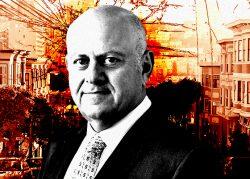From the head of the world’s largest industrial landlord being robbed at gunpoint outside his San Francisco home to the sudden ubiquity of the phrase “builder’s remedy,” there has been no shortage of intriguing storylines in the Bay Area’s real estate landscape this year.
As 2022 draws to a close, The Real Deal looks back at all the articles published over the past 12 months and selects the “buzziest” ones. “Buzziest” is a subjective term, so we reviewed internal data showing which articles garnered the most page views in a given week to help make our picks. Bay Area Editor Joel Russell and National Managing Editor Jerry Sullivan played a role in the selection process.
This rundown isn’t meant to be exhaustive, but it provides a bird’s-eye view of the main storylines in the region.
CEO holdup
San Francisco’s office market continues to lag behind every other major U.S. metro area, dragged down by the enduring popularity of remote work arrangements. And the negative headlines that dogged the city last year continued into 2022, with perhaps the most glaring example being “Prologis CEO Hamid Moghadam robbed at gunpoint in San Francisco.”
That was the headline of a July article about the head of the world’s largest industrial landlord being mugged by several men outside of his Pacific Heights home. It was TRD’s most-read story during the week July 24-30.
Moghadam, whose company is based in San Francisco, wasn’t injured during the robbery, although thieves made off with his Patek Phillipe watch. The event inspired him to double down on his efforts to help the Bay Area address its ills; he wrote an open letter to Mayor London Breed calling crime in the city “absolutely unacceptable.”
Votes for housing
Among the most prevalent storylines in the Bay Area this year was how many of its cities and towns could approve their housing elements — a planning document outlining how a municipality will achieve its state-mandated housing production goals — and have the state green-light the plan before the Jan. 31 deadline.
The housing element process has ignited debate amongst Bay Area residents and elected officials about how to boost the region’s housing stock outside of what’s in those documents. Some of those potential solutions ended up on the ballot of this year’s November elections.
In San Francisco, a pair of warring housing measures, Propositions D and E, would have streamlined the city’s approval process to create more affordable homes, albeit for projects with different affordability levels. Both measures were too close to call the day after polls closed, but neither ended up passing — a disappointing outcome for “yes in my backyard” groups and Mayor London Breed, a Prop D supporter.
A’s squeeze play
Across the Bay Bridge in Oakland, the city elected a new mayor and two new City Council members in the November elections, meaning three of the governing body’s eight seats have new faces. Those results “scramble the game plan” to keep the city’s professional baseball team in Oakland.
New mayor Sheng Thao has not been as supportive as the outgoing Libby Schaaf on trying to get a commitment from the A’s on a new stadium and to proceed with the large-scale residential and commercial development that would accompany the venue. Thao has voiced her desire to get a deal done; however, she has stressed that certain conditions would need to be met. They include ensuring that the A’s meet the city’s affordable housing demands — 15 percent on-site, 20 percent off-site — and taxpayer dollars won’t be used for project financing.
Oakland and the A’s failed to meet the November deadline to bring a formal development agreement to the City Council. That doesn’t mean the project is dead; rather, any possible deal between the parties is likely to wait until next year. In the meantime, the two sides continue to negotiate behind the scenes on what community benefits the A’s will need to provide the city in exchange for the right to develop a new waterfront ballpark, one that would be among California’s largest developments ever through the creation of a mixed-use neighborhood around the stadium.
Builder’s remedy
Builder’s remedy is an untested provision of a 1990 state law known as the Housing Accountability Act. Under the law, cities deemed noncompliant by the state with their state-mandated housing plans lose the ability to approve or deny projects that have a certain portion set aside for affordable housing.
The kicker is those projects are automatically approved if at least 20 percent of their units are affordable, or if the entire development is dedicated to moderate-income tenants.
In the space of a couple of weeks, builder’s remedy went from a relatively unknown provision to a hot topic amongst YIMBYs, NIMBYs and Bay Area city officials previously unfamiliar with the term.
TRD’s Southern California bureau broke the news in October that a single development firm had filed at least a dozen projects totaling about 4,000 units under the so-called builder’s remedy provision in Santa Monica. The projects alone represent an addition of more than 7 percent to the city’s housing stock.
In the Bay Area, TRD has published articles on how the provision could ignite a housing boom in San Francisco, which is notoriously slow in approving residential projects; summarized a YIMBY Law-led workshop for Bay Area residents and developers to learn more about builder’s remedy; and explained how cities like San Francisco can expect to see hundreds of builder’s remedy applications starting Feb. 1, the day after the state’s housing element approval deadline for Bay Area municipalities.
All of those articles were among the most-read ones during the weeks in which they were published. As soon as Jan. 31 becomes Feb. 1, builder’s remedy will return to the headlines as developers rush to capitalize on the legal strategy for project approval.
Read more







